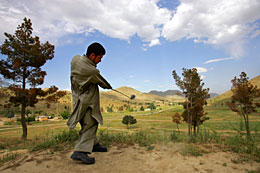
UNFAIRWAYS: Tricky hazards abound at the Kabul Golf Club
There are herds of goats on the fairway, strands of barbed wire by the greens and an old Taliban training camp is nestled behind the ninth hole. Certainly, the Kabul Golf Club is not the most genteel of places at which to enjoy a round or two of golf, but there are few as memorable. After a 26-year hiatus, during which its course occasionally served as a battleground in the bloody conflict between the Russian army and the mujahedin, this striking facility is once again open for business—although it's hardly business as usual when playing the challenging course. The greens are brown—formed from a mixture of oil and sand—and the roughs are very rough. In fact, they're pocked with artillery craters.
Fortunately, the dependable caddies are thoroughly familiar with the terrain. They regularly shift loaf-sized rocks away from lies and will helpfully point out the water hazards, which are easily overlooked because they are dry all year round. The club's rules suggest that players use their imaginations and take penalty strokes when shots land in the "water," even if balls are actually playable. "This way," the rule book cheerfully notes, "you can retrieve your ball without getting wet."
In winter, heavy snow drifts on the 6th green can pose a conundrum. Do they count as bunkers or as hazards? The answer may be found somewhere in the PGA rules, but the Kabul Golf Club's caddies have a more practical solution to the problem. If they can find the white ball somewhere in the snow, then it's regarded as playable; if they cannot, that will count as another penalty.
With duffers, the caddies are extra patient and encouraging, and best of all, they mercifully stop counting your strokes after you've reached four over par on any given hole. But whatever your score, a round at the Kabul Golf Club will broaden your golfing experience. After all, how many courses boast land mines as a potential hazard?
—by Aryn Baker